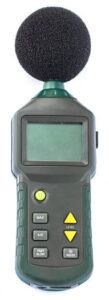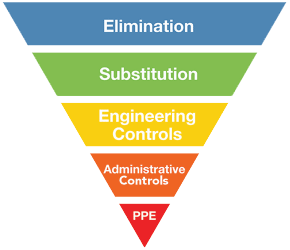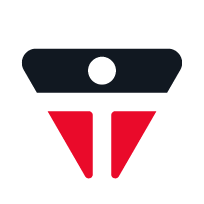
"Sound" is defined as what we hear. "Noise" is defined as unwanted sound. Both can be harmful for hearing. The terms "noise" and "sound" are often used interchangeably, despite the slight differences in definition.
We hear various types of sounds and noise on a daily basis. Low noise is not always harmful, but if it is persistent or rises in volume it can still cause health effects including noise-induced hearing loss (NIHL). NIHL is also called permanent threshold shift (PTS), as well as temporary threshold shift (TTS), and tinnitus (buzzing in the ears). A workplace can be considered at risk of causing NIHL if workers has to raise their voices to be heard, or if their ears are ringing at the end of the day. Even when infrequent, loud impact noises in the workplace can still cause NIHL. Impact noises are sounds from objects colliding, such as a punch press making contact with a die plate.
Learn more about Noise-Induced Hearing Loss here.
Sound Level Monitoring and Noise Dosimetry

A Dosimeter (Sound Level Meter)
Sound levels in the workplace can be monitored using a sound level meter. These measurements are only a snapshot of a worker’s exposure to noise, since noise levels vary throughout the work shift and different work stations. A worker’s personal exposure to sound is more accurately measured using a dosimeter.
Both sound level meters and noise dosimeters measure the levels and the frequencies of sound, in decibels (dB) and hertz (Hz) units, respectively. The decibel scale is a logarithmic scale that measures volume. The instruments can "hear" sound as a human ear can through the use of built-in filters. These sounds are typically reported in A-weighted dB units (dBA), but sometimes C-weighted dB (dBC) are used in the case of very high frequency sounds. Frequency and pitch are directly correlated – lower frequencies have a lower pitch, and higher frequencies have a higher pitch. Humans can hear in a range from 20 to 20,000 Hz, though the upper range is harder to hear for older people.
Regulations in the Workplace
There are provincial regulations for the level and duration of sound exposure in Ontario's workplaces. Sound levels must be below the equivalent sound exposure level for 8-hours (Lex,8) of 85 dBA with a 3 dB exchange rate for shifts of different durations (O. Reg. 381/15: Noise). The 3dB exchange rate means that for every 3dB increase in noise level, the exposure time should be halved (e.g., Lex,8 = 88 dBA for 4 hours only). The Lex,8 in Ontario’s federally regulated workplaces is 87 dBA with a 3 dB exchange rate. The Ontario Lex,8 is more protective than the Federal limit, and there is more agreement with using the 85 dBA limit. Based on the current evidence, OHCOW recommends an Lex,8 of 80 dBA, with the submission and supporting reasons including citations outlined here.
Contact OHCOW Occupational Hygienists if you’d like help interpreting your worksite’s sound level measurements or your personal noise dosimetry.
Health Effects of Noise
Noise induced hearing loss (NIHL) is one of the most common work-related illnesses in Ontario. As mentioned previously, hazardous workplaces that can cause NIHL are not always obvious. Sometimes infrequent but loud impact noises that occur sporadically can do damage to hearing.
Other adverse health effects of noise exposure include temporary threshold shift (TTS) and tinnitus. TTS is when noise exposure results in a temporary hearing loss that recovers after rest. A worker might have to turn up the car radio volume at the end of the work day, but will turn it back down the next morning. Repeated TTS can lead to a permanent threshold shift (PTS), or NIHL. Tinnitus is ringing or buzzing in the ears.
Hierarchy of Controls for Noise

Elimination is the highest level of control within the hierarchy of controls. Unfortunately eliminating the noise from the workplace is not always possible. Substitution is the next level of control. Even if it may cost more, a company should opt for the quietest equipment possible.
Engineering controls are also efficient in reducing workplace noise. These measures can include installing sound absorptive materials around machinery or between walls, using sound barriers or unit absorbers, or using vibration damping materials.
Administrative controls, such as scheduling workers’ tasks during machine downtimes, can be adopted to reduce the workers’ exposure to excessive noise.
The use of PPE is the last resort in the hierarchy of controls: if the above control measures cannot be adopted, or are adopted but don’t lower exposure to below the Lex,8, then hearing protection devices (HPD) such as ear plugs or muffs must be worn.
Ontario legislation requires employers take all measures reasonably necessary to protect workers from exposure to hazardous sound levels; these measuresinclude engineering controls, work practices, and if those are not possible, hearing protection devices(O. Reg. 318/15: Noise). Learn more about how you can use the hierarchy of controls to develop an effective hearing conservation program by clicking here.
Resources
Doing Something About Workplace Noise (OHCOW fact sheet): https://www.ohcow.on.ca/wp-content/uploads/2022/01/noise_five_steps.pdf
Sound Level Monitoring Apps:
NIOSH SLM. https://www.cdc.gov/niosh/topics/noise/app.html
OpeNoise. https://play.google.com/store/apps/details?id=it.piemonte.arpa.openoise&hl=en_CA&gl=US
SPL Meter. https://play.google.com/store/apps/details?id=com.ktwapps.soundmeter&hl=en_CA&gl=US
For some very “sound” reasons, noise measurement apps on iPhone are generally more reliable than Android. In addition, the NIOSH SLM app has been tested and validated according to standards at the NIOSH Acoustics Lab.”
Slides
Noise-Induced Hearing Loss (2022 slides)
Noise: Its Effects and Methods to Reduce Exposure (2014 slides) https://www.ohcow.on.ca/edit/files/25thanniversary/James%20Miuccio%20-%20Doing%20Something%20about%20Noise%20presentation%20oct%2031%202014.pdf
Noise-Induced Hearing Loss Prevention (2017 slides) https://www.ohcow.on.ca/edit/files/news/20102015/OHCOW.NIHL.Oct15.pdf
Presentations
Noise (2016) https://www.youtube.com/watch?v=COreV58llT0
Raising Awareness about Noise (2017) https://www.youtube.com/watch?v=AcKCn1LtiTk
ODAP Working Group on Noise (2018) https://www.youtube.com/watch?v=_09jgHKo1Ck
Noise-Induced Hearing Loss Prevention (2015) https://www.youtube.com/watch?v=qeISNPmAvVw
Noise: Its Effects and Methods to Reduce Exposure (2017) https://www.youtube.com/watch?v=7biyvhx-MqY
Occ-complishment: New System Noise Resources - IHSA and OCHOW (2017) https://www.youtube.com/watch?v=Q-rhDbrPXnI
International Noise Awareness Day (April 27, 2022): https://noiseawareness.org/
Noise Fact Sheets (CCOHS (Canadian Centre for Occupational Health & Safety)): https://www.ccohs.ca/topics/hazards/physical/noise/
A Guide to the Noise Regulation under the Occupational Health and Safety Act (Ontario Ministry of Labour, Immigration, Training and Skills Development): https://www.ontario.ca/document/guide-noise-regulation-under-occupational-health-and-safety-act
Noise-Induced Hearing Loss

